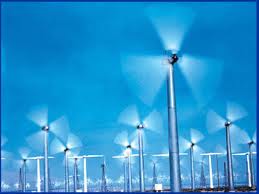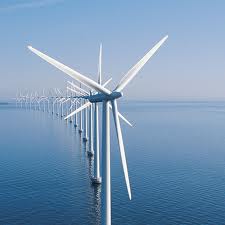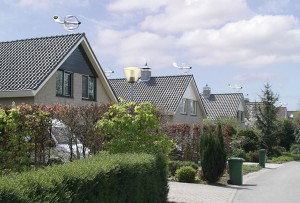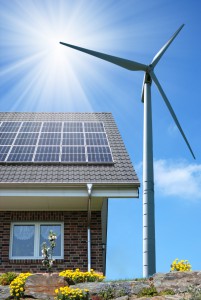A renewable home energy contractor can help you turn the energy of the wind into clean, renewable electricity for your home.
1. Evaluation – Is wind energy a smart choice for you?
Does the wind blow fast and consistent enough at your property to make wind energy an economically wise choice for you? This question is not simply answered since many factors influence wind levels. To gain a clear picture of whether wind energy will work for you, a professional wind assessment study to accurately define, measure, and forecast available wind resources will need to be made at your site. Your renewable home energy contractor can do just that.
Using wind resource maps and databases, a wind turbine contractor will evaluate the mean annual wind speed in your area. Since your specific location can have varied winds, wind speed and direction will also be measured on-site and analyzed. A thorough assessment of the terrain, layout and vegetation of your property will be performed taking into consideration any obstacles that may hinder the speed and force of wind flow including buildings and the present and future height of trees.
Typically, wind turbines are placed in open plains and on hilltops or hillsides to ensure access to strong, prevailing winds. The bottom of the turbine blade should be a minimum of 30 feet above anything within 300 – 500 feet of the turbine. Since the speed and the force of the wind are essential factors to the amount of power a wind turbine generates, the higher the turbine is, the more wind energy can be harnessed. Your technician can locate the best place for your turbine to produce energy for primary, supplemental, or backup power use.
2. Design – A wind turbine sized to meet your needs
The most common residential wind systems consist of a single horizontal-axis turbine with two or three blades that can produce just enough power to meet the demands of a home, farm or small business. To determine the height of the tower and the size of the rotor you require, your contractor will estimate the amount of energy you need against how much energy production you can expect from a wind turbine based on your average annual wind speed.
The space needed for your system depends on the type of tower your turbine uses. A guyed tower consisting of a metal tower supported by guy cables and earth anchors needs a large radius that is one-half to three-quarters of the tower height, whereas a self-supporting lattice or a monopole/tubular tower takes up less room. Whether your wind energy will be used to power your home or a water pumping system for your farm, the length of the wire run between the turbine and its load will be carefully evaluated since a substantial amount of electricity can be lost the longer the wire run.
Your renewable home energy contractor will handle any local permits and zoning requirements as well as neighborhood ordinances regarding wind turbine construction in your area.
3. Construction – Harnessing the wind’s energy
While construction of industrial wind farms can take several months to a year or more depending on their size, residential wind turbine towers usually take just a few days. The assembly of your turbine system may vary. Typically, the tower of the turbine is secured to the ground on a cement base at the chosen site. This cement, once poured, will need to cure for several days.
The tower poles and the generator may be hoisted and secured to the base using a crane. If a tilt-down tower is used, the assembled system can be raised and lowered automatically. This makes maintenance easier for the homeowner. Your contractor will also install all the system components that connect the wind turbine to your home or other application.
4. Maintenance – Keeping the wind working for you
Wind energy systems are one of the most cost-effective home-based renewable energy systems available. Proper placement of your turbine is essential to its performance and stability since poor placement in extremely turbulent conditions may shorten its working life.
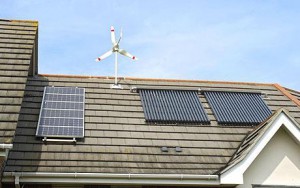
Your renewable home energy contractor will provide ongoing regular inspections as well as monitoring services to ensure the highest production of electricity possible. Quality wind turbines are engineered for safety and are designed for over 20 years of operation to give you maximum return on your renewable energy investment. If properly installed and maintained, your new wind turbine will supply you with clean, inexpensive energy for many years.
